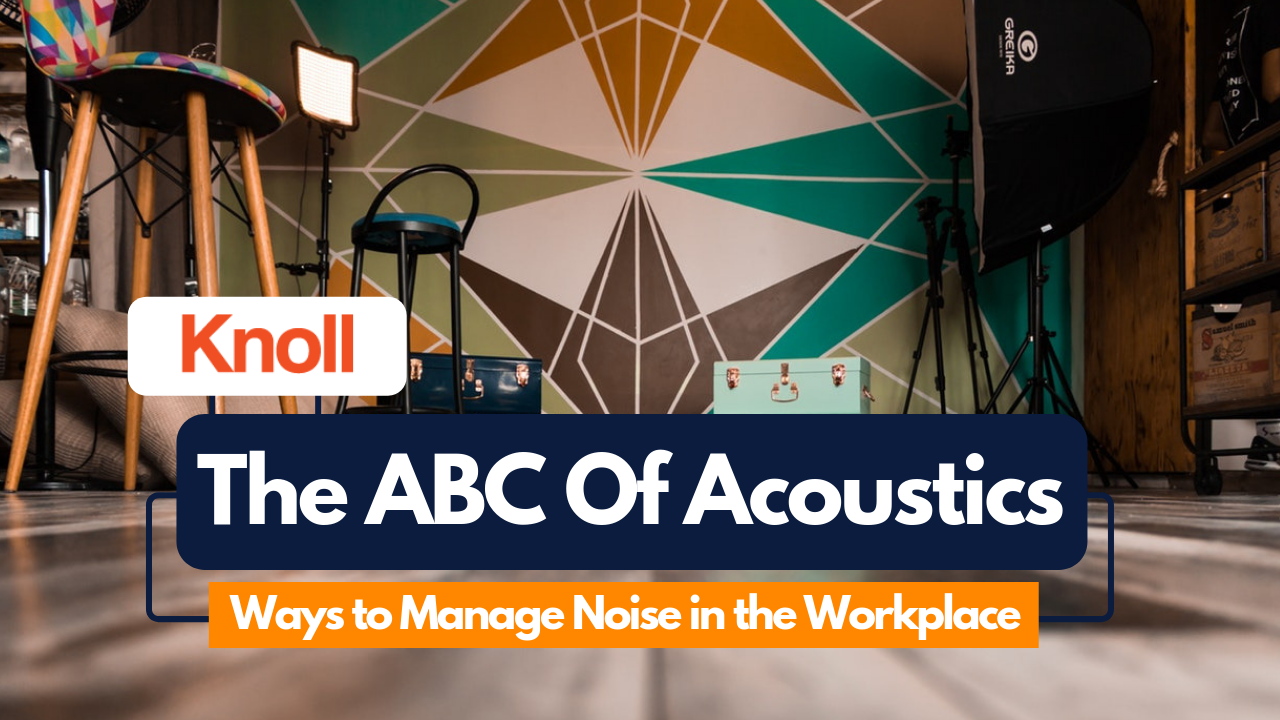- Noise in the workplace isn’t just about the source — it’s also about how sounds reverberate and move around within a given space.
- Knoll recently published a research report claiming that nearly 75% of employees feel that managed noise levels are an important quality in the workplace.
- The ‘ABC’ of acoustics refers to 3 general ways to manage noise in the workplace: absorption, blocking, and covering.
Knoll recently published the research report “Noise at Work: Addressing Noise in the Open Plan”. Citing the Leesman Index, the research states that nearly 75% of employees feel that managed noise levels are an important quality in an effective workplace. Unfortunately, only 30% of employees within the Leesman database are satisfied with the noise levels in the workplace.
This is not a surprise for many. Afterall, unwanted noise is among the top workplace complaints.
According to Knoll, “dissatisfaction with noise is statistically the strongest indicator of poorly perceived productivity and the main source of workspace dissatisfaction.”
In recent years, open plan workplaces have been under attack, with many even hoping they cease to exist overall. This is too much of a drastic measure, especially considering that there are several strategies that can be implemented to hack the open office.
In fact, for all its downsides, open offices offer a plethora of benefits, including increased collaboration, engagement, and knowledge transfer. These types of workspaces can also lead to greater space efficiency, which can help companies save thousands of dollars, especially in a business environment where people aren’t tied up to a specific place and time.
Suggested Reading: “A New Workplace Narrative: Findings from Gensler’s 2019 Workplace Survey”
Before we dive into the ABCs of open office acoustics, let’s look at some facts. According to Knoll:
- Well-designed sound environments enable concentration and facilitate communication, freeing people to collaborate without distracting their neighbors.
- Poor office acoustics negatively impact health and wellness. They increase stress and fatigue, which is linked to high blood pressure, digestive disorders, headaches, hypertension, cardiovascular disease, psychosomatic illness, sleep deprivation, and more.
- Once people are distracted by unwanted noise, it can take up to 25 minutes for them to regain concentration. Knoll states that professionals lose up to 86 minutes a day due to noise distractions.
- Planning and implementing an acoustics strategy can improve wellbeing, productivity, and happiness at work.
Sound and Noise 101
Knoll’s research states that it’s important to distinguish between sound and noise.
“Sound is a vibration that travels through the air or another medium, and can be heard when it reaches a person’s ear. Noise is unwanted sound that can be loud or merely annoying: a coworker’s conversation, a loud paper shredder, a noisy air conditioner.”
Suggested Reading: “Hell is Other People: The Real Problem behind Workplace Noise”
In simple words, sound is when you’re hearing something that you are interested in and noise is when you hear something that you’re not interested in or shouldn’t be hearing at all.
When it comes to noise in the workplace, it’s not just about the source, but also how sounds behave within a given space. This depends on the levels of reverberation in the building; on how sounds move throughout a given space.
The above is highly influenced by elements such as building surfaces, furniture, design materials, people, and space layout. “This is why spaces that are full of highly reflective surfaces — e.g. concrete floors, open ceilings, brick walls, windows, and glass — tend to be uncomfortably loud”, Steve Johnson, founder ADI Workplace Acoustics, told Knoll. This happens because these surfaces create a bandshell effect when sound transfers from one place to another.
“Sound is being concentrated and directed off reflective surfaces and creating a megaphone effect. (…) A narrow corridor of glass, tile, concrete and/or other hard surfaces can funnel sound from a loud area to a quieter one.”
This is why “good acoustics requires managing the paths that sounds travel between.”
The ABC of Acoustics
Absorb
Noise absorption refers to the act of minimizing noise by absorbing sound levels through the use of “porous materials that catch and hold the sound rather than bounce it back”.
This type of material can be used in ceilings, floors, walls, furnishings, accessories, workstation elements, and fabrics.
“High ceilings create reverberant acoustics that blur voices in the distance”, they allow people to have face-to-face conversations without their voices being intelligible a few feet away. If your flexible workspace doesn’t have a high ceiling, you should consider using hanging baffles, suspended ceiling tiles, or acoustic foam in order to absorb sounds.
When it comes to the floor, embrace carpets, especially if your floor is covered by hard surfaces. As for walls, decorations, accessories, and furniture, there are various sound absorbing materials and decorations that can be easily incorporated into a workplace without sacrificing design and aesthetics. Also, plants are your friends when it comes to sounds, so make sure you’re giving your workplace some green life.
Pro tip: sound should be captured as close to the source as possible.
Block
There can’t be any unwanted noise levels if you’re blocking sounds in the first place.
Sound blocking, therefore, is managing noise by avoiding sounds. This can be done by designated quiet areas (like trains and libraries do). “Blocking sound in select locations and separating noise-generating activities from quieter ones helps manage noise and improve speech privacy in an open office.”
This is why it’s important that a coworking space balances “me” and “we” spaces.
Another strategy to block sound is to break up workspace areas. Instead of having one huge open plan room where you can fit 150 people, break the room up into three areas that can accommodate 50 people. These areas should be, ideally, separated with a meeting room, fabric panels, carpet expanse, partitions, bookshelves, or plants.
Pro tip: isolate copiers, shredders, and other noise-generating machines from open areas.
Cover
Covering sound is about masking noise with sound generation equipment. Covering doesn’t mean eliminating. Johnson told Knoll that in order to cover noise, the sound “doesn’t need to disappear 100%, it just needs to disappear enough that it’s not drilling into our consciousness.”
Covering is about “creating organic sound that people are accustomed to hearing”, such as nature sounds. Knolls calls this type of noise pink noise, which is different from white noise as pink noise is “smoother and more soothing across all frequencies.”
And if the above fails, there’s always the option of using high quality headsets.


 Dr. Gleb Tsipursky – The Office Whisperer
Dr. Gleb Tsipursky – The Office Whisperer Nirit Cohen – WorkFutures
Nirit Cohen – WorkFutures Angela Howard – Culture Expert
Angela Howard – Culture Expert Drew Jones – Design & Innovation
Drew Jones – Design & Innovation Jonathan Price – CRE & Flex Expert
Jonathan Price – CRE & Flex Expert













